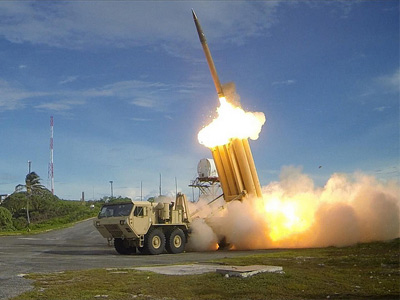Mind the Gap: Don't Forget Missile Defense Radars
The interceptor missiles get the attention and the money—but the radars that support them are getting shorted.
 Much of the current debate on missile defense focuses on the need for more missile interceptors, as well as the politics of reconciling Russian and Chinese opposition to the systems with the Iranian and North Korean missile threats. Although these are important issues, our leaders on Capitol Hill and in the Pentagon must not neglect the fielding of adequate numbers of radars and other enablers to support these systems.
Much of the current debate on missile defense focuses on the need for more missile interceptors, as well as the politics of reconciling Russian and Chinese opposition to the systems with the Iranian and North Korean missile threats. Although these are important issues, our leaders on Capitol Hill and in the Pentagon must not neglect the fielding of adequate numbers of radars and other enablers to support these systems.
The cold reality is that without adequate sensors to detect and track missile threats, the interceptors will be useless. Congress needs to keep this connection in mind as it finalizes its work on this year’s defense spending bills and plans for future budget years.
Radars play an essential part in our national defense. The U.S. Ballistic Missile Defense System (BMDS) architecture includes networked sensors—especially ground- and sea-based radars—which search, acquire, detect and track ballistic missiles and discriminate between warheads and decoys. Remote data-linking creates virtual missile-defense arrays involving ships, ground batteries, and airborne and spaceborne sensors.
The Ground-Based Interceptors (GBIs) in Alaska and California rely primarily on four fixed radar facilities in Alaska, California, the UK, and Greenland. Using a twenty-thousand-mile fiber-optic communications network, these radars communicate with the GBIs and other sensors and can detect objects as far as five thousand kilometers away.
Aegis BMD cruisers and destroyers, which currently have AN/SPY-1 radar transmitters and MK99 Fire Control Systems, are now regularly on patrol in the Mediterranean, Persian Gulf, and western Pacific. Thus far, the Aegis radar combined with the SM-3 interceptor has hit a various targets under different testing conditions, in addition to successfully shooting down a satellite.
The Aegis air and missile defense system are widely available. They can be found on more than one hundred warships, including U.S. Navy cruisers and destroyers and vessels serving many U.S. partners. Regretfully, the sequester process and other reductions in the U.S. defense budget are already curtailing shipbuilding plans and forcing premature retirements of existing ships. By FY2018, there should still be some thirty U.S. BMD-capable Aegis ships.
The Army Navy/Transportable Radar Surveillance and Control (AN/TPY-2) radar, which tracks all classes of ballistic missiles and identifies small objects at long distances, provides our warfighter with even greater capability. It is a billboard-size, high-resolution radar with a range of more than 4,000 kilometers that can make measurements potentially useful for discriminating between warheads and decoys or debris. According to the Missile Defense Agency (MDA), the AN/TPY-2 radar “provides overlapping sensor coverage, expands the BMDS battle space, and complicates an enemy's ability to penetrate the defense system.”
All these U.S. radars work best when integrated into a wide network with the rapid and extensive exchange of data among them. In terminal mode, the AN/TPY-2 acts as a fire-control radar for the THAAD system, designed to intercept short- and medium-range missiles. In forward-based mode, it can track ballistic missiles in their ascent phase and contribute fire-control data to the Aegis ships. Recent tests have demonstrated the ability of THAAD and AN/TPY-2 to operate effectively with the Aegis radar to provide a layered missile-defense framework against multiple missile threats.
Despite AN/TPY-2’s utility, budget cuts and sequestration have forced the MDA and Congress to scale back their purchase of radars from eighteen to eleven. More are clearly needed.
Of the existing inventory, six are used by THAAD batteries, while others are presently forward deployed in northern Japan, Israel, Turkey and Qatar. The last AN/TPY-2 is currently being used for testing but is slated to deploy to southern Japan, to augment the already functioning AN/TPY-2 in northern Japan, at the Shariki base.
U.S. officials would like to deploy a AN/TPY-2 in the Philippines, where it could help track ballistic missiles launched from North Korea. A new AN/TPY-2 radar would likely be constructed in the northeast United States to provide updated tracking information of missiles and reentry vehicles that approach the United States from the east.
In addition to acquiring more radars, we also need to support the infrastructure that sustains these radar systems—which are often at remote sites with dilapidated facilities—as well as R&D efforts to create more sophisticated radar systems, with a better ability to discriminate warheads from decoys and debris.
Defense-industrial-base issues are also relevant here. Without new orders, the AN/TPY-2 line may shut down and would be hard to reconstruct. BAE Systems CEO Linda P. Hudson spoke to this challenge for defense suppliers during a recent speech to the Atlantic Council, and the general sentiment applies here: “Once you close the doors of these plants, once you let these employees go, it will take years and hundreds of millions, perhaps billions, to rebuild—if it is even possible.”
With mounting pressure to cut defense spending, investing every dollar wisely on both back-end enablers and front-end spears is more essential than ever.
Richard Weitz is the director of the Center for Political-Military Analysis and a senior fellow at the Hudson Institute.
